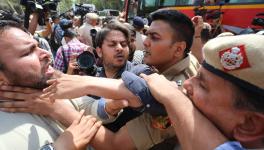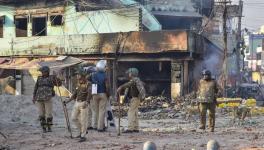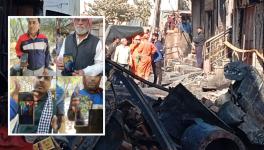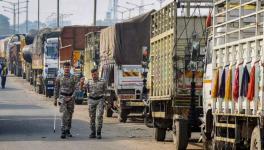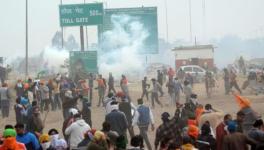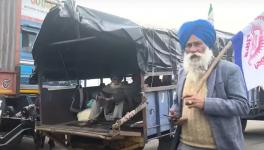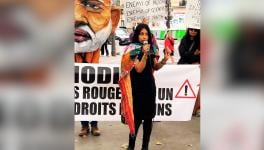Delhi Violence: Shattered Hopes, Destruction and Courage
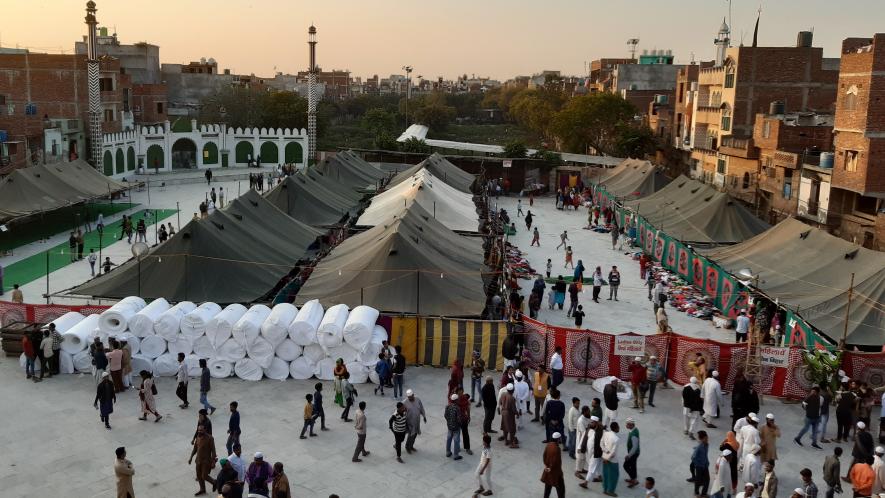
Relief camp set up by Delhi Waqf Board at Mustafabad Eidgah
New Delhi: Garhi Mendu village in North-East Delhi’s Ghonda Assembly constituency wears a deserted look. Burnt, ransacked and looted houses and shops testify the large-scale sectarian violence that ravaged the area from February 23 to 26. The small village now has no Muslim family as all of them have fled after the rioters went on rampage on February 24-25.
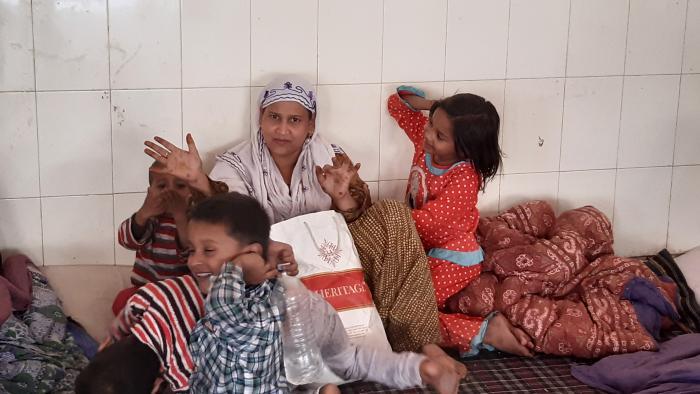
A mother is always the best friend. A riot victim of Garhi Mandu along with her children at Shriram Colony's relief camp.
An uneasy calm still prevails there, with any stranger walking in the streets being looked upon with suspicion. A visible discomfort is palpable among the local population who don’t want the burnt debris to be photographed and reported.
Aquil Ahmad (65) and his wife, however, managed to gather some courage and did not flee until they were attacked and forced to leave. When the only mosque in the village close to Ahmed’s house was ransacked, it sent panic among all Muslim families, who started fleeing in the dead of February 24 night
. But he mustered courage and decided to stay there, assuming that the elderly and responsible people of the society would intervene and pacify the rioters. But he was wrong, as nothing of that sort happened.
“Soon after maghrib azaan (call for the prayer offered after sunset), our mosque, which is close to my house, was vandalised on February 24 evening. Everything was destroyed. It created panic among Muslims in the village, and they began fleeing for safety. They should not have done so. I did not leave. But, it was a longest night for us. Aggressive chants of ‘Jai Shri Ram’ and abusive anti-Muslim slogans were echoing in the air. We spent the entire night in extreme fear, hoping that the next morning will bring peace,” Ahmad told NewsClick at a relief camp set up by the Delhi government in a community marriage hall in Muslim-concentrated Shriram Colony in Khajuri.
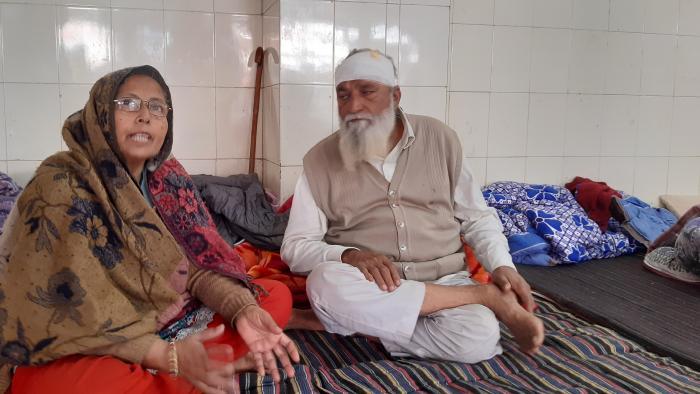
Aquil Ahmad along with his wife at a relief camp at Shriram Colony in Khajuri
He went on to narrate his ordeal. “The next morning at around 7:45-8 a.m (February 25), they — the rioters in the age group of 18-25 years — began looting, vandalising and finally torching houses belonging to Muslims. The first target was my house. I was dragged out and brutally thrashed with sticks and iron rods. After I was hit on head, I fell on the ground and lost consciousness. I don’t know what followed after that. When I regained consciousness, I found myself in blood-soaked clothes. We were rescued by a few policemen, who brought us here,” he said.
“I saw my house, which had no valuable item except few clothes, a bed, utensils and few other things to fulfil our basic needs, ransacked and partially burnt,” he added.
What happened after he fainted was described by his wife. “We were having food in the evening when a mob comprising local boys broke the entrance gate, which I had bolted from inside and put piles of wooden blocks to support it so that no one could easily break the gate. The boys broke the gate with the help of a heavy iron rod. They barged into our house and dragged my husband out, hurling abuses on us and mercilessly beating him. Some of them then sprayed some inflammable substance — perhaps petrol or thinner — on our bed. They tried to light it up but the match box they were carrying did not work. They used our matchbox, which was lying on a table close to our bed. Once the flame began rising, they ransacked the place.”
She said the men seemed to be in a hurry. As the bed started burning, she said, the rioters left her house. “I immediately poured water and doused the fire. One of them saw me doing this and shouted while leaving: ‘Isne to aag bujha diya (she has doused the fire)’. But the mob didn’t return. After they moved out, the police reached and rescued us,” she said.
The couple said the mob burnt all the vehicles parked in their way. It was clear that they knew who the vehicles belonged to.
There is a visible pattern in the violence that took place in the village. Those Muslims who live in houses belonging to the dominant Gujjar landlords as tenants were not harmed. A few of them are still living there.
The entire village has come up on agricultural land close to the Yamuna riverbed that was sold to migrant Muslims by local Gujjar landlords. The community now wants to forcefully regain the sold land from the Muslim population, taking advantage of the opposition by the minority community to the amended citizenship legislation.
The violence in the national capital was triggered after Hindu nationalists attacked protest sit-ins against the controversial Citizenship Amendment Act (CAA), the National Population Register (NPR) and the proposed National Register of Indian Citizens (NRIC).
Muslims are demanding a rollback of the law that they describe as “discriminatory” and against India’s secular Constitution. They fear the CAA, coupled with the NRIC, will de franchise them and render them stateless. The NPR is a pre-requisite of the nationwide NRIC. The data collected under the NPR, suggests its notification, will be used for the citizenry register without any consent.
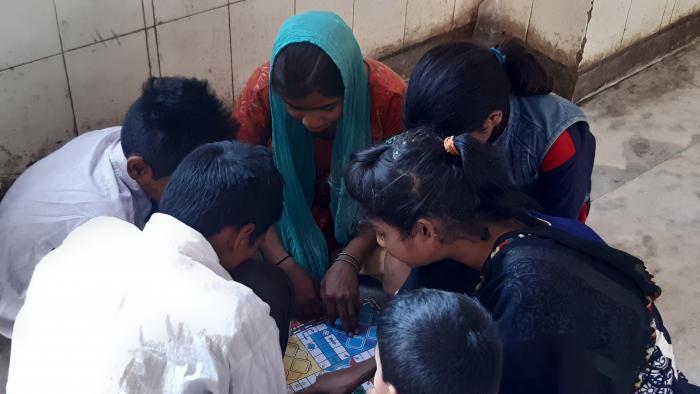
Young boys and girls huddled round a strategy board (ludo) at Khajuri's Shriram Colony relief camp
“They (Gujjar landlords) candidly admitted that they want to evict us and grab the land we had bought from them. When we were escaping, I was told, “Tum bhag jao, tumhare makanon pe qabza karna hai. Tumahara yahan kuch nahin hai ab. (You run away. We need to grab your houses. You own nothing here),” the elderly couplewho originally belong to Bijnor in western Uttar Pradesh, was told.
Ahmed’s family has a small business of matchbox sticks and had been living in the village for the past three years after buying a piece of land. They said others in the community had been living there for the past 14 years.
Asked as to how the social bond of the last 14 years got broken so suddenly and whether the locals intervened and asked them to return, they said: “None of our neighbour tried to intervene and save us. They preferred to act as mute spectators. It’s their boys, and no outsider, who were indulging in the violence. They successfully created a narrative that the anti-CAA protest is actually an opposition to Hindus, which is not true. Muslims of the country are opposing the government’s decision, not a particular community. We were not even part of any anti-CAA protest. Why did they attack us? ”the couple said.
The trust deficit and fear are so deep that the couple is not ready to go back home even after security assurance given by the sub-divisional magistrate (SDM) of the area. “SDM saheb kah rahe hain ki tum wahin raho, hum unmen se kisi ko zimmedar banayenge (The SDM is asking us to go back and he will make someone in the area to ensure our safety and security). But we are not convinced. Ab to himmat nahin hai laut kar jaane ki. Is baar to bach kar chale aayen, agli baar shayad jaan na bache (We don’t have courage to go back. We managed to save our lives this time but who knows about the next),” Ahmed said.
Nafisa, a resident of the same village, was struggling to console her two young children who were suffering from high fever. “They (the rioters) first forced us to leave our house and then burnt it down. My father has suffered injuries in the attack. We had built the small two-room house with the hard- earned money of my husband who has a ferrying business in Mumbai. It was destroyed in few minutes,” she said and broke down.
Nafisa said when they were crying, begging and yelling, no one from the locality came to their rescue. But she said she wished to return if complete normalcy returns as majority of the people in the village have no other option and staying in relief camp is not possible.
“I pray to God that life returns to normal so that we can return home. Who don’t want to live in the relief camp. Though there is mistrust, as no one from our village has so far contacted us and asked us to return, we don’t have any other option. We will see how life can once again be started from scratch,” she added.
Thirty-six-year-old Nasrin, a mother of three — two daughters and one son -- was inconsolable. She had lost her husband two years ago. Her house, the only saving of years of labour both the deceased husband and wife had put together, has been completely destroyed. She had a small grocery shop, the only source of livelihood after her husband passed away, which too was looted and vandalised.
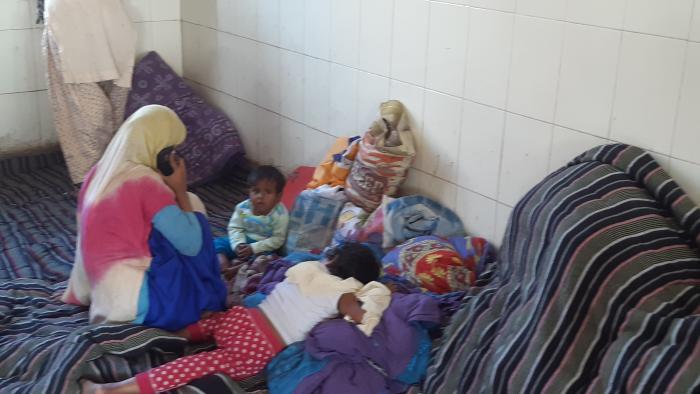
Nasrin, a widow, lost her house at Garhi Mendu and the only source of income. She is not facing the camera as she is unable to control tears
“My younger brother died a month ago. Therefore, I was at my parent’s place to console them. The phone call I got on February 25 evening from one of my neighbours shattered my life. I was informed that my shop as well as house was looted and set ablaze. Where will I go now and what will I do? Who will take care of my children? How will I feed them?” she said.
Nisar Ahmad (50) had to marry his daughter — the eldest among six children. A carpenter by profession, he wanted to send his daughter to her in-laws’ place. But he was unaware of what destiny had in store for him. His house was attacked, looted and then set on fire.
“They first looted my house and took away all the ornaments and cash I had saved for my daughter’s marriage. They (rioters) did not spare a single thing. Whatever was left was put on fire. The police took us to the village for identification and damage survey. I could saw my entire life’s earnings turned into ashes. Though I am illiterate, yet I am ensuring that all my children get good education. And they were doing so. But now a dark future awaits them as I am left with nothing,” said Ahmad with tears rolling down his face, showing photographs of the debris of his house.
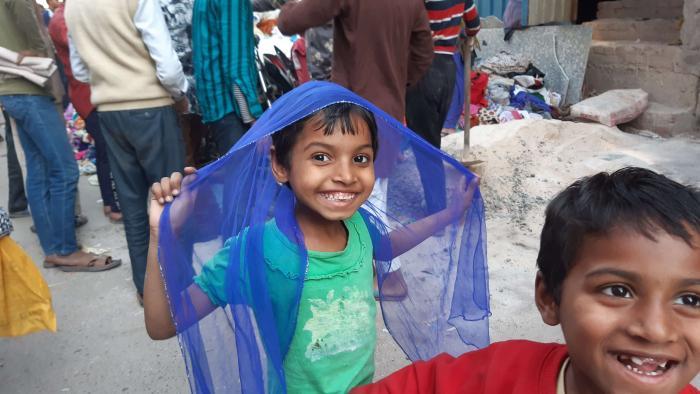
Happiness under the shadow of fear. A smiling young girl flauting her stole she picked up from the heap of used clothes brought as part of relief.
A resident of Shiv Vihar, which witnessed maximum damage of life and property, who is temporarily living in a relief camp set up the Delhi Waqf Board at Mustafabad Eidgah, said: “Humne itna bada hungama kabhi nahin dekha tha, sirf suna tha iske baare men. Lekin ab dekh liya (I had only listened but never witnessed such a large-scale violence. I have seen it now). There was a frenzied mob all around, aggressively chanting ‘Jai Shri Ram’ slogans. We somehow managed to escape late Monday (February 25) night. We were also concerned about the safety of my children, especially my daughter. But fortunately, we safely managed to flee when my house was attacked,” he said recounting the horror.
“My house was torched. The ornaments of my daughter in law and my daughter were looted. My house was turned into ashes,” she told NewsClick struggling to control her emotions. “Humgama to din se hi ho raha tha lekin humen laga ki mamla shant ho jayega, lekin hua nahin. Hamare colony men to goliyan bhi chal rahin thin (There was unrest since morning but we were of the view that it will cool down. But it did not happen. There were bullet firing in our street). We kept calling the police, but they turned up only when everything was looted, vandalised and turned into ashes.”
Asked how they managed to escape, she said: “They entered our homes. But, some masked men among them even helped us to flee. We could not recognise them.”
She said she had 13 buffaloes as well, but when they went back, they found none. “The house in which I was living with my family was burnt down. It had two tenants, whose belongings were also looted. Now, we are out on the streets, empty handed, depending on others for even a piece of bread,” she added.
These are not isolated stories of sufferings and ordeal that the victims of the worst violence the city has witnessed after the anti-Sikh riots in 1984. Every individual in different relief camps has his or her own stories to share, of the sorrow of losing their near and dear ones, losing everything they had. Such destruction and scale of violence is evident in all riot-affected areas in East Delhi, where the death toll so far has reached 49.
There are stories of rioters going on rampage, allegations of police inactivity and complicity, while there are also stories of love, peace and brotherhood in this atmosphere of hatred. But there is one common thread -- the absence of governance of the city government and the Centre.
Get the latest reports & analysis with people's perspective on Protests, movements & deep analytical videos, discussions of the current affairs in your Telegram app. Subscribe to NewsClick's Telegram channel & get Real-Time updates on stories, as they get published on our website.









